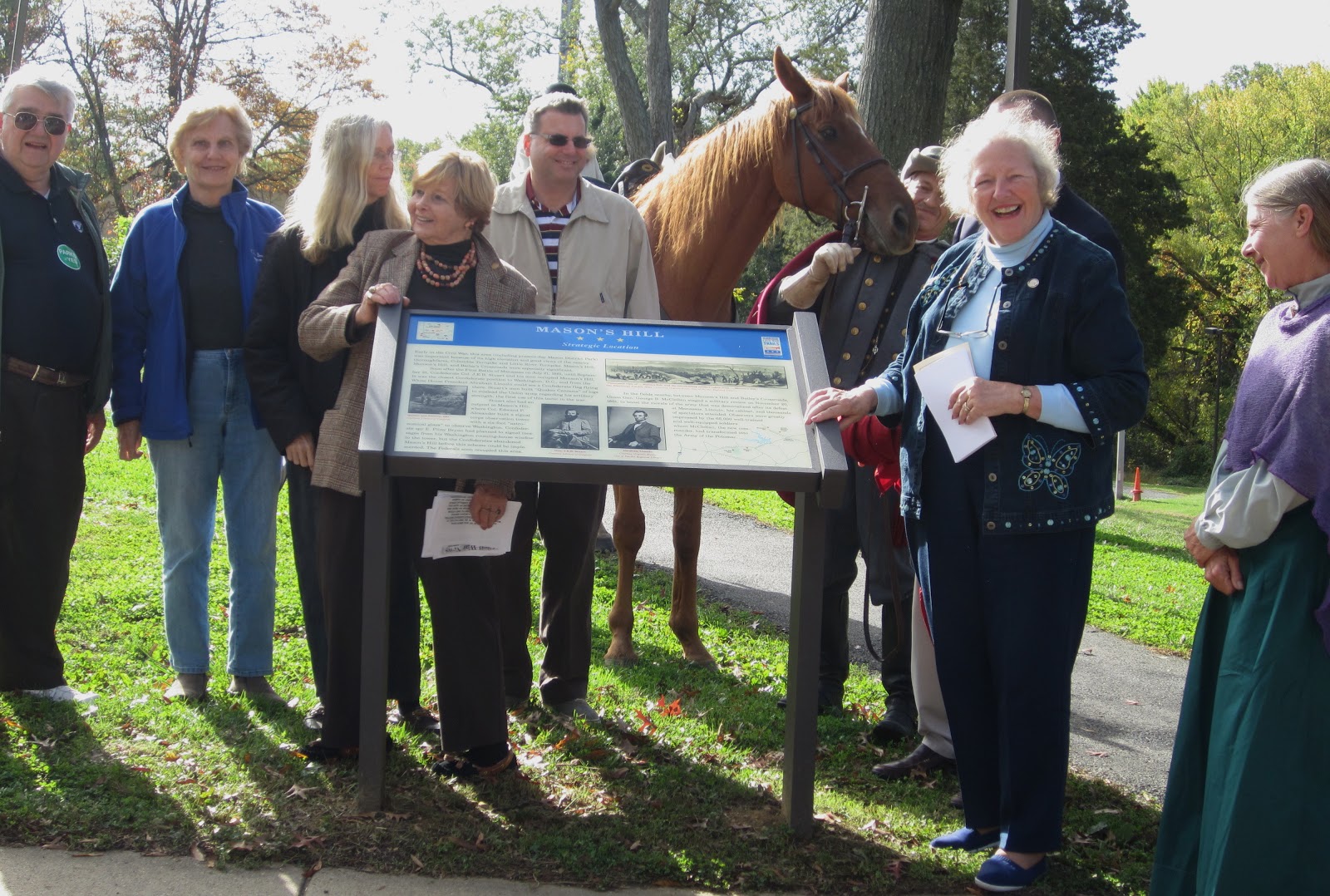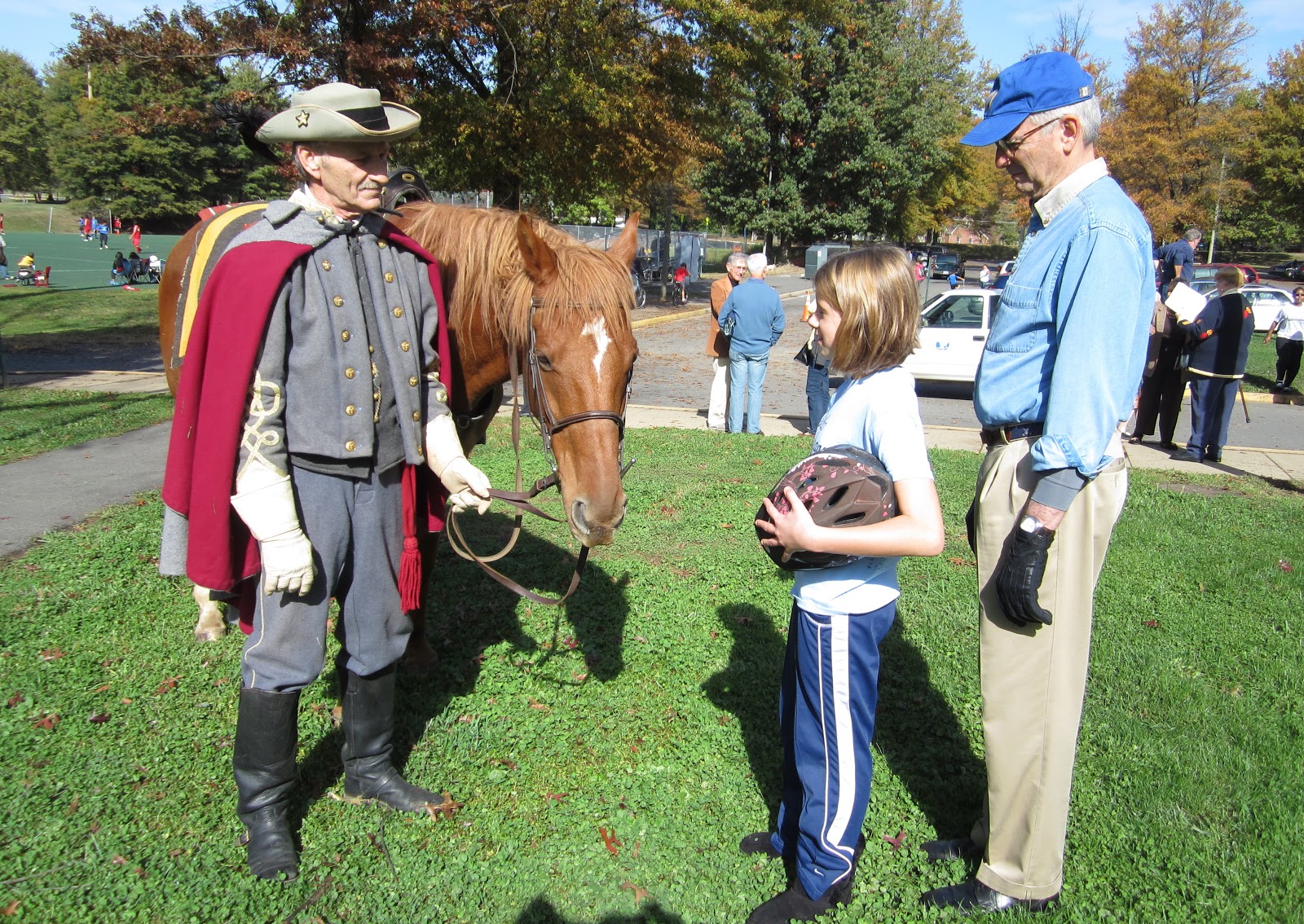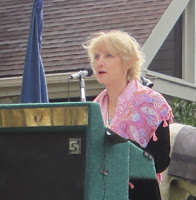Descendants of historic families lend authenticity to marker dedication
 |
| Mason Supervisor Penny Gross points to the new interpretive sign in Mason District Park. Frank Vajda of the Park Board is on the far left, and Mary Munson Root is on the far right. |
during the Civil War and before came to the dedication of a historic marker Oct. 20 in
Mason District Park in Annandale.
The interpretive sign describes several events of historical significance
that happened in the area. Mason’s Hill, which was located near where the Mason
District Government Center is now, was important because of its strategic elevation.
JEB Stuart had an outpost at Mason’s Hill, and there was an observation tower
allowing his men to keep an eye on Washington, D.C.
Stuart also occupied Munson’s Hill in
Bailey’s Crossroads for three months in 1861. It was the first place the Confederates installed “Quaker cannons,” which were fake cannons made out of logs to fool
the Union Army into thinking they had some artillery strength.
 |
| Jimmy Fleming as Mosby with Tim Frawley and his daughter, Kai. |
Frank Vajda, the Mason representative on the Fairfax County Park Authority Board. “Throughout Virginia and the South, small places such as this played
large and significant roles in the outcome of this heroic conflict.”
county are part of a larger project to educate the public about the historical
significance of this area during Fairfax County’s observance of the
sesquicentennial of the Civil War. The signs will be listed on maps
and guidebooks produced by Civil War Trails.
 |
| Julie Munson |
bring history tourists to the area who are likely to eat in Annandale
restaurants and otherwise support the local economy, said Patrick Lennon, chair
of the
Fairfax County Civil War 150th
Anniversary Planning Committee.
grandson of Founding Father George Mason and son of John Mason, a U.S. senator,
said Naomi Zeavin, who represents the Mason District on the Fairfax County
History Commission.
owned a farm at Munson’s Hill, spoke at the dedication ceremony. Julie Munson
described how her ancestor had to flee temporarily for opposing slavery and
supporting Lincoln’s campaign for the presidency. His daughter, Lucy, met with Lincoln in the White House to tell the president about the destruction of property by the Confederates. Lincoln wrote a letter recommending her for a job with the federal government.
Even with that recommendation, though, she didn’t get the position.
described how John Mosby, the “Gray Ghost,” raided Munson’s Hill on Sept. 25,
1863. Mosby’s Raiders searched the house looking for Munson, and mistakenly
captured his son, Daniel, instead. There was a skirmish in Falls Church, and
Daniel was able to escape and go home.
Jimmy Fleming, a noted Mosby portrayer, was there, too, with his
horse, Willie. Mosby didn’t have a special horse; he “borrowed” horses from
farms as he needed them, Fleming said.
 |
| Bonnie Fairbank and Naomi Zeavin |
Hachaliah Bailey (1775-1845), the original “Bailey” of Bailey’s Crossroads,
also spoke at the ceremony. Hachaliah moved from New York to Virginia
because he needed a place where the circus he had founded could spend the
winter.
In 1837, he purchased a 320-acre farm for $6,000. The house, near the intersection of what is now Columbia
Pike and Leesburg Pike, had 100 rooms, Bailey said. It burned down in 1952 after
being vacant for a number of years.
engraving showing Lincoln’s Grand Review of the Troops, which took place in Bailey’s
Crossroads in 1861. Bailey said his ancestor supported the North during the
Civil War, and Union soldiers stayed at the farm, although his son was drafted
into the Confederate Army.
Bonnie Fairbank, wearing a hoop skirt and seven layers of
clothing, usually portrays Martha Washington in Colonial Williamsburg, but appeared
at the Mason Hill ceremony as Annie Clark of the historic Clark House on
Columbia Pike. In the midst of the Civil War “Annie took care of everyone,”
providing food and care for the wounded soldiers on both sides, said
Fairbank, although she probably favored the Rebels.
High School, called historic markers “magic markers” that keep history alive
for schoolchildren “when so much of our heritage is being lost every day.”


Did the County videotape this?
no, but Naomi sokol zeavin did and in a month she will Edit it and it will be on channel 10.
Naomi Zeavin is wonderful. What fantastic pictures.
Great, will look for it!